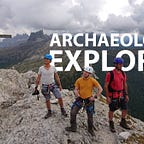Via Ferrata: the journey of the explorers.
Written by Wim Van Assche
Preparation:
If we want to combine archaeology and Via Ferrata the choice to go to the Dolomites was obvious for me. In that region they made, during World War 1, a lot of “Iron Paths” to move troops and supplies over the rugged terrain. But that didn’t make the choice easier to pick one out.
Without knowing my teammates very well I set up some training challenges.
First, we had to climb 100 meters hight. David and I are living in Belgium, Dade lived at that moment in Sicily close to the sea, and Covid-19 chasing its way through Europe forced us to be creative on this one. None of us was going to make it to a mountain cliff to do the 100m challenge.
Second challenge was to walk or run 50K. This was meant to make every single team member get out of the house and start training. A training program helped to set goals and that way the three of us build some basic endurance.
At the end of September restrictions on travelling where in our favour so David and I set of to Italy. Dade joined us at the airport and we set off to Cortina D’Ampezzo.
A lovely hotel “La Locanda del Cantoniere” on the way to the Falzarego pass will be our basecamp for the next days. The hotel, built on the remains of the road inspectors’ house from the first World War (the Locanda was the habitation of the cantoniere or road inspector), set in the woods along the Dolomites State Highway is perched on a small and panoramic hill. The perfect place to prepare our adventures in the mountains and chill after a hard day walking and climbing the mountains. [1]
Day 1
At the Forte Tre Sassi our Via Ferrata journey starts. The castle, located near the Passo di Valparola, was constructed by the Austrians in 1897. At the beginning of the war (May 1915) the Austrian Hungarian troops retreated to the Valparola pass. A defensive line was created and during the next years they build trenches and tunnels to defend the pass against the Italians. [2]
Where is that Via Ferrata?
Information I found on a website is giving 2 options for reaching the start of the Via Ferrata. The longer option is using the Goiginger tunnel to reach the start. This is the route we choose. But the map on the site is giving me a wrong impression of the location of Via Ferrata. [3]
The map is showing a ladder on the north side of the mountain, so we start looking for tunnels and cables on that side. After hours of walking, climbing and scrambling the mountain we reach the top. But we haven’t found the Via Ferrata.
We did find on the other hand the start of the Goiginger tunnel and a lot of trenches, buildings and other remains of the Great war on the top of the mountain.
Day 2
This morning our cameraman Claudio arrived. This is going to be our first day of real filming. Not having found the correct route we decide to take the short route to make sure we find the cable. And indeed, after a short walk (30’ normally, but 2h with the filming) we stand at the start of the cable.
Let’s go for the direct route!
Although it is an easy Via Ferrata the route is going all the way up the rockface. So, Claudio is staying at the foot of the wall and uses the drone to make some awesome footage. The 3 of us start climbing. At the beginning it start easy with a leaning slab and a lot of hand and foot holds. But the hight is getting on the nerves of David (although his slippery shoes add some extra adrenalin as well). Especially at the end of the route where the cable goes straight up a vertical wall. But every one of the team gets up to the top of the climb.
Because of the filming the day is already getting to its end, so we decide to film the introduction and some b-roll of the trenches and do some more exploring.
Day 3
Since the Goiginger tunnel is a very important topic in our project we decide to visit the tunnel a 2nd time (we found the start of the tunnel on day 1 remember) to do some extra filming with drone and professional camera. So, we again set of to the north face of Sasso Di Stria.
We take the tunnel through the mountain.
We walk the 500m long tunnel and explore every bit of it. It is good we have some headlights with us because it is pitch dark in many places. Happy to arrive back in the daylight (and feel the heat of the sun) we exit the tunnel close to the saddle with the Goiginger emplacements. We continue our walk around the base of the mountain to the start of the Via Ferrata to climb it once again.
After the climb, that went way better than the day before we all enjoy the amazing views on the surrounding Dolomites. Imagining that some cruel episode of history will always be part of this beauty.
Useful websites on Via Ferrata Sottotente Fusetti
https://lagazuoi.it/EN/percorso13-Via-Ferrata-Sottotenente-Fusetti
https://www.guidedolomiti.com/en/ferrata/ferrata-fusetti-on-sass-de-stria/
https://www.ferrate365.it/en/vie-ferrate/ferrata-tenente-fusetti-sass-de-stria/
Gear we used to record our Pilot episode
3 GoPros
1 Panasonic S1
1 Panasonic Lumix
1 Sony A7III
1 Mavic air 2
Our cellphones
2 Gimbals
2 mics ;)
Bibliography
[1] www.locandadelcantoniere.it (10/2020)
[2] https://lagazuoi.it/EN/pTer11-Sasso-di-Stria-191517 (10/2020)
[3] https://www.ferrate365.it/en/vie-ferrate/ferrata-tenente-fusetti-sass-de-stria (01/2021)
